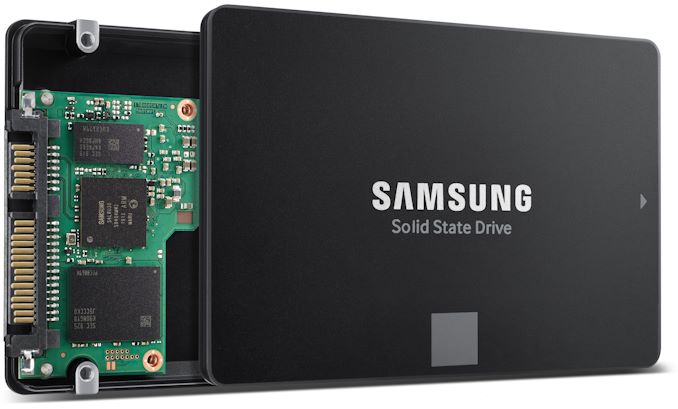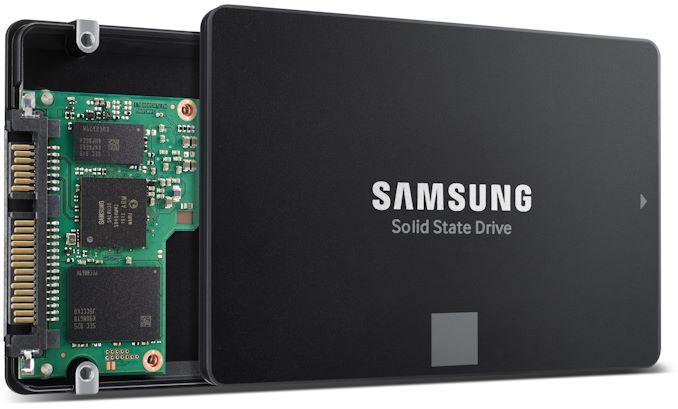Samsung Unveils 6th Generation V-NAND Memory with Up to 136 Layers
by Anton Shilov on August 6, 2019 3:30 PM EST
Samsung on Tuesday introduced its sixth-generation V-NAND memory, which in a bid to further improve capacity and density, features over 100 active layers. To make V-NAND with over 100 layers viable from performance point of view, the company had to use new circuit design technology. The new memory features 10% lower latencies and consumes 15% lower amount of power when compared to Samsung's previous-generation V-NAND.
Samsung’s 6th Generation V-NAND features up to 136 layers as well as charge trap flash (CTF) cells. The new memory uses one stack and does not use technologies like string stacking to build over 100 layers. In order to ensure minimal errors and low latencies, Samsung had to use a new speed-optimized circuit design. The latter enables the new 3D TLC 256 Gb chips to offer below 450 microseconds (μs) latency for write operations and below 45 μs for read operations, which is 10% faster when compared to 5th Generation V-NAND, according to Samsung. Meanwhile, the latest V-NAND also features lower power consumption than its predecessors.
It is noteworthy that the new 256 Gb 136-layer V-NAND devices use 670 million holes, down from 930 million holes with the previous generation, which means that the new chips need fewer process steps and are easier to manufacture. What is important is that Samsung plans to use its 136-layer architecture with speed-optimized circuit design to build V-NAND devices with over 300 layers by mounting three of the current stacks on top of each other (thus tripling a chip’s capacity).
Initially, Samsung will offer 256 Gb 3D TLC 136-layer V-NAND devices that will first be used for Samsung’s 250 GB SSDs. Later this year Samsung intends to release 512 Gb 136-layer V-NAND devices that will be used for other drives as well as eUFS storage solutions.
Speaking of the 256 GB 6th Gen V-NAND SSD, it is important to point out that it uses Samsung’s new controller marked as the S4LR030/S94G4MW2.
Related Reading:
- Samsung Shares SSD Roadmap for QLC NAND And 96-layer 3D NAND
- Samsung's New 512 GB UFS 3.0 Chip for Galaxy Fold, Now in Mass Production
- Samsung Starts Production of 1 TB eUFS 2.1 Storage for Smartphones
- The Samsung 970 EVO Plus (250GB, 1TB) NVMe SSD Review: 96-Layer 3D NAND
Source: Samsung











41 Comments
View All Comments
GreenReaper - Tuesday, August 6, 2019 - link
If they only need that big a circuit board, you have to wonder if it'd be better just to cut the case in half!Also... I know you're working from releases for pipeline stories, but is it truly necessary to note that "it's noteworthy", or "important to point out"? If a particular fact wasn't truly notable or important, presumably you just wouldn't mention it at all? Picky, I know, but it bugs me. :-/
s.yu - Tuesday, August 6, 2019 - link
If we pack a 2.5" form factor full of flash memory it should far exceed 10TB.raywin - Tuesday, August 6, 2019 - link
and your budgetFunBunny2 - Tuesday, August 6, 2019 - link
good point. I've always wondered why, at least Enterprise, SSD don't do that. there are sufficient address lines, and power shouldn't be an issue, after all if you load chassis with a dozen or so SSD, you'll draw about the same power.Jorgp2 - Tuesday, August 6, 2019 - link
The idea is that with insane capacities on a SATA interface, is that your per GB bw goes way downsoresu - Monday, December 16, 2019 - link
128 TB just on the last generation alone (92 layers).29a - Tuesday, August 6, 2019 - link
If they cut the case size in half it wouldn't be compliant with the 2.5" hdd form factor.Valantar - Tuesday, August 6, 2019 - link
Yeah, that would make laptop use near impossible. Even mounting in most desktop brackets would be loose and weird.beginner99 - Wednesday, August 7, 2019 - link
Laptop yes is a problem but desktop? I mean you don't even need a mounting spot you can just tape the 2.5 drives somewhere. it's not like ssds need decoupling or need to be mounted especially secure.Azurael - Wednesday, August 7, 2019 - link
The OEM market seems to consist almost exclusively of m.2 drives now, whether SATA or NVMe. Of the remaining market for 2.5" SATA SSDs, how many do you think end up in desktops? I'd hazard a guess that the overwhelming majority of 2.5" SATA SSDs sold in 2019 are retrofitted into older notebooks which came with HDDs and require a standard full length 2.5"/9.5mm height form factor. Samsung isn't going to make a different version of the drive to fulfill the wishes of a tiny proportion of the market for the device. If you need one, you could always design and 3D print your own.